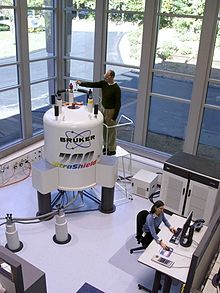Chemical
Composition of A Poem
I
dreamed that I poured a poem
inside
the tube of NMR
and
the graph presented
no
hydrogen
in
the composition
that
means
the
poem was dry
no
trace of water
nor
impurity
*NMR:
Nuclear Magnetic Resonance, a useful instrument in chemistry to determine the
number and position of hydrogen in a chemical structure.

Bruker 700 MHz NMR spectrometer.
Nuclear magnetic resonance provides scientists with an elegant, precise way of determining the chemical structure and properties of materials and is widely used in physics and chemistry. Magnetic nuclei absorbs radio frequency energy when placed in a magnetic field; when absorption occurs, the nucleus is described as being in resonance. Different atomic nuclei within a molecule resonate at different radio frequencies for the same magnetic field strength, and their observation allows any trained user to discover essential chemical and structural information about the molecule. During World War II, Edward Mills Purcell was part of the team that developed radar at the Massachusetts Institute of Technology's Radiation Laboratory in Cambridge, Massachusetts; his work on the production and detection of radio frequency power and on its absorption by matter laid the foundation for Isidor Rabi's discovery of NMR in molecular beams, which copped him the 1944 Nobel Prize in Physics; Rabi would later. 1964, become the 1st person to hold the rank of university professor at Columbia University in New York. In 1946 Purcell at Harvard University in Cambridge and Felix Bloch
ReplyDeleteat Leland Stanford Junior University in Stanford, California, separately expanded Rabi's technique for use on liquids and solids, leading to their sharing the 1952 Nobel. (Bloch had been Werner Heisenberg's 1st graduate student at the Universität Leipzig, and became Stanford's 1st professor of theoretical physics; in 1951 Purcell was the 1st to detect radio emissions from neutral galactic hydrogen.) In 1948 Russell and Sigurd Varian formed Varian Associates to market their inventions such as the klystron, a linear-beam vacuum tube used to amplify high radio frequencies. In 1951 Varian Associates filed a patent for a "Method and means for correlating nuclear properties of atoms and magnetic fields;"the next year they developed the NMR HR-30. In 1953 the firm was the 1st to occupy a site at Stanford Industrial Park in Palo Alto, California (the birthplace of "Silicon Valley"); one of their early employees was bookkeeper Clara Jobs, who would soon give birth to Steve Jobs (who launched the microcomputer revolution when he founded Apple in 1976.)